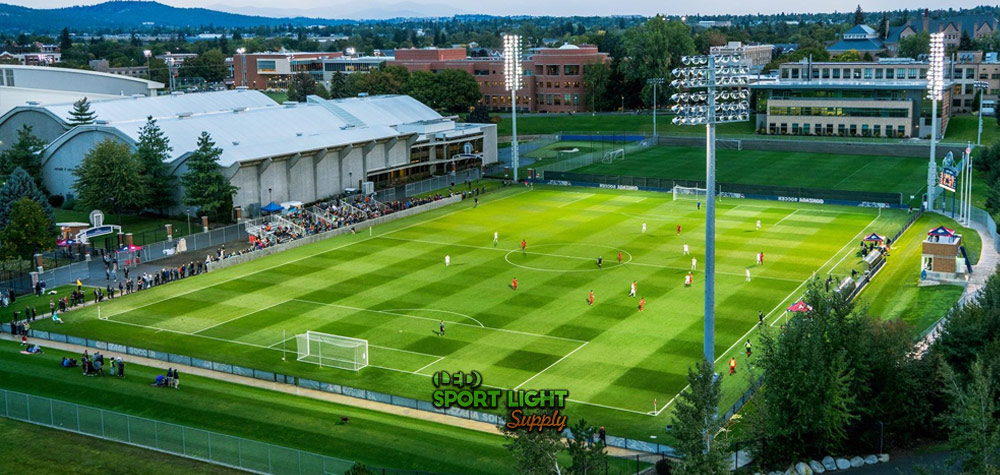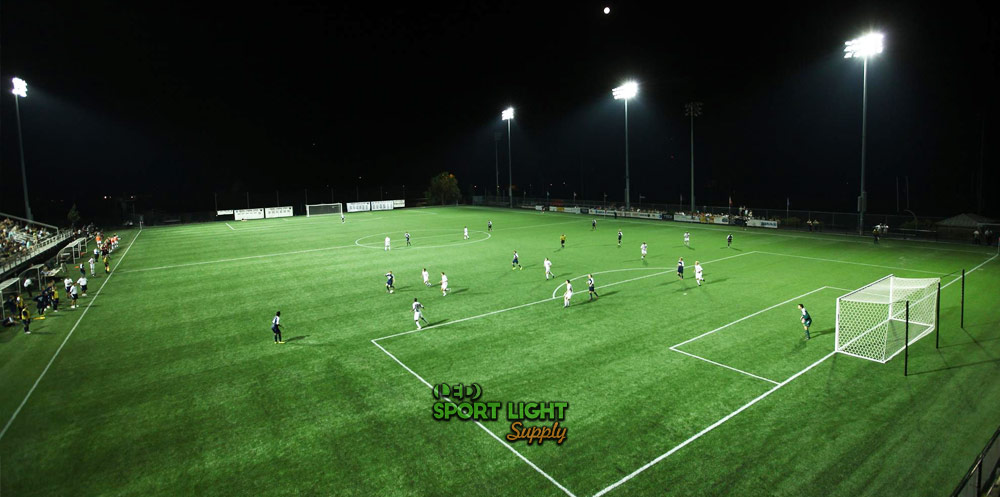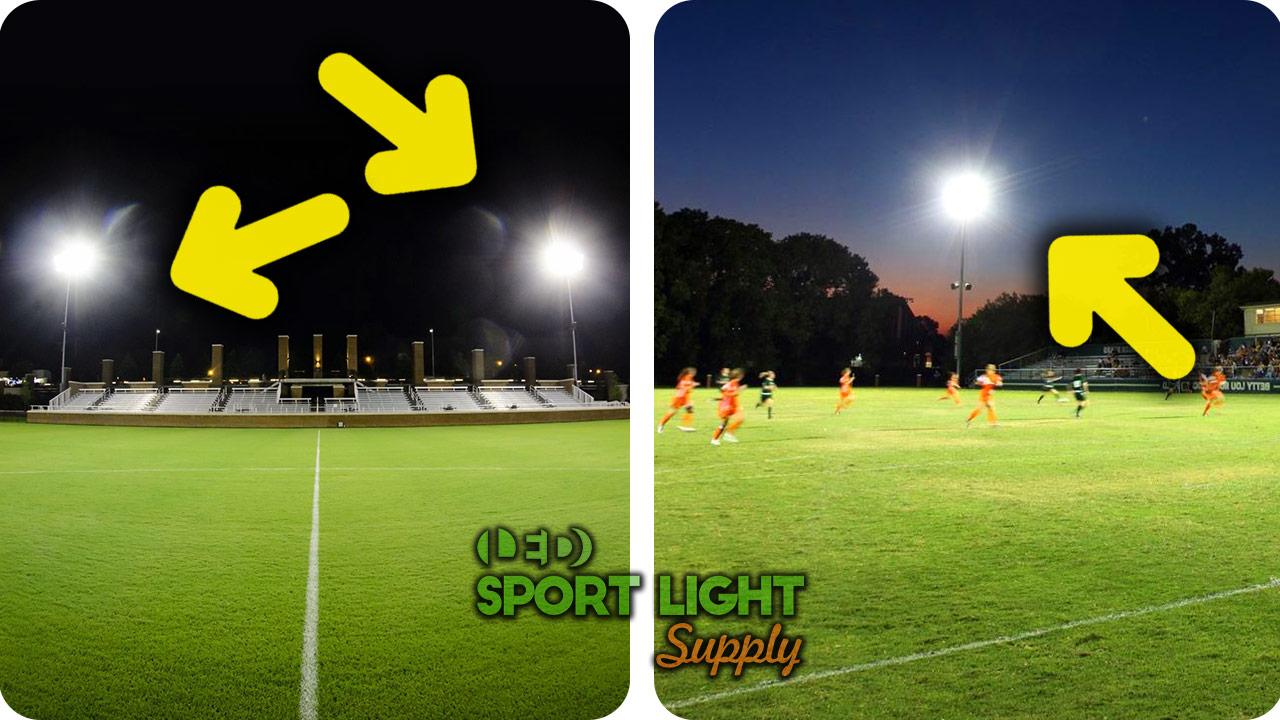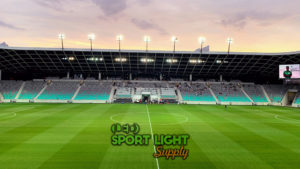There is a major difference in how a field is illuminated and the reasons have become a near-science for professional sports. For many of us who don’t understand how field lighting works, this guide helps to serve as a reference tool. Not only to see why one or the other has specific good Vs bad points but assisting field lighting needs. If your job is to light-up a field, you should know these viable points and their uses.
What is side lighting on a sports field?
Every sports field has 4 corners that will be idea spots where side lighting can be placed. The diagonal illumination covers the field from nearly all directions. It also allows the players and spectators to see from every direction. Depending on the size of playing fields in stadiums or arenas, lights need to be placed on high mast poles. The distance and height of these lights all have important Lumen requirements.
The problem is that this kind of lighting is fine for some applications but usually has major drawbacks. These can be solved through the use of corner lighting. The next section will discuss what side lighting does to correct this problem.
What is the corner lighting on a sports field?
Corner lighting is one absolute solution to remove a common problem that happens with side lighting. The first problem begins with shadows that are formed by using diagonal lights placed at each corner. Corner lighting helps reduce ground shadows that diagonal lights create. Most standard sports soccer and football fields use a system of lights that add additional lamps along the edge of the field. These are typically called the 6-pole or 8-pole lighting configuration.
Professional fields for larger venues use even more light as corner lighting. But this is often for industry lighting standards that the pro leagues request. It’s also needed for television where slow-motion cameras can study and replay athlete movement.
Side vs corner lighting: Which is better for a sports field and stadium? Their pros and cons
Once again, this is not to compare the disadvantages Vs improvements but helps to define why these two are symbiotic. They both have Pros and Cons as you will see, but in combination, they complement their strengths and weaknesses.
1. Lamp cost Vs running cost
Corner lighting

One of the biggest problems with corner lighting is the great height that they need. Since they are placed into each corner, this isn’t so easy when you have a structure built around large fields. Since these floodlights need more Lumens due to the distance and height, these need to be calculated beforehand. A mathematic formula helps determine how many Lumens are needed for each corner.
With each corner covering and overlapping a portion of the field, naturally, the light will light up a field. If you’re using metal halide or high-pressure sodium to light-up a sports field, the running costs will be high. It makes better sense to convert to LED corner floodlights to reduce these Wattage expenses. Replacing older stadium lamps is an incredible cost-reduction that will save money over a longer period.
The initial outgoing cost of sports lighting can be considered an investment that pays-off for the next 20-25 years. This is a yearly saving that’s a return on the replacement cost also. The costs to maintain older lighting is a continual upkeep expense that’s year-round. LED corner lighting systems are more cost-effective since they are low maintenance.
Side lighting

After corner lighting is set-up with LED floodlights, you’ll still have to compare the issue with darker field patches. Using additional sidelights with the 6 to 8-pole configuration will make the playing field more uniformly lit. Using LED side lights, you will need less lighting since these lights are closer to the edge of the field. This additionally is a cost-effective way to have better visibility over the whole playing surface.
Commonly, high schools or colleges can get away with 6-poles however 8-poles cover more empty darker field spots. These are best placed behind spectator bleachers on either side of the leading goal area zones.
2. Glare
Corner lighting
High mast lighting usually has more glare issues because of floodlights with smaller beam angles. The older style of lights always needed glare cover and light shields which has high levels of glare. This is both uncomfortable for the athletes and spectators. With LED lighting, these issues can be more controlled mainly in part that LEDs have a narrow field of focus. With other types of incandescent lighting, it needs to be controlled using reflectors.
LEDs can also use reflectors that reduce corner lighting flare better than MH or HID lights. But if a field isn’t set-up properly for these high mast poles, these can be issues that impact the viewing experience. It can almost certainly be felt by the players who will see this difference more on the soccer or football field.
Side lighting
When side lighting is used, there are fewer glare problems because it’s a high beam angle to light closer objects. Now, this is especially improved when the 6-8 pole position is used to light up smaller regions. The angle of side lighting is normally not as high as mast lighting either. Side lights can illuminate players and the field, bringing the Lux rating up to optimal levels. In short, it helps reduce the corner lighting glare problems.
With lighting that nearly encircles playing fields, the number of Lumens can be more balanced with fewer flare issues involved. But this all depends on the number of side lights used and the amount of LED glare control that light units can provide.
3. Shadow
Corner lighting
Lighting an entire sports field for all corners is effective but the shadow problem is pretty obvious. Even if mast pole light is evenly lighting a field you still get dim areas scattered in certain spots. This is why side lighting needs to be added to fill-in these areas, providing higher Lux throughout the field. Without side lighting, the shadows of players on the field can appear confusing.
This might be fine for recreation practice fields, but this wouldn’t be accepted for college or semi-pro sports fields. This is the reason you don’t see professional stadiums with just corner lighting. It needs fill-in side lights to cover the whole field.
Side lighting
If you’ve seen the local playing field at a park or for amateur sporting, it will have the standard corner lighting. But this doesn’t remove the weaker spots that make the field appear patchy. Even the best corner lighting cannot solve this problem by itself. It will need fill-in lights. This is why the option to design the 6 to 8-pole layout is essential for more professional lighting.
Side lighting gives the field and player additional light where it’s needed most. The appearance of field shadows is lessened and athletes and spectators can see action that’s happening in front of them. No matter what side you view a field, there’s improved visibility for everyone involved.
4. Heat generation
Corner lighting
Hot stadium light is a common problem that affects a game. If we are talking about HID or MH lights, this can be felt all the way down to the field itself. The real problem is when banks of stadium lights are packed together edge to edge. They create an incredible amount of heat that may lead to lights bursting and burning out. Add some poor rainy weather and this makes it possible to compare your instant prediction.
Using LED lights is much better for corner lights since they can vent more quickly. These have built-in heat sinks that are behind the light fixture. Cool air can circulate over the heat sinks and cool corner lights efficiently. Even in foul weather, the IP rating can ensure that LED fixtures will function in all sorts of bad weather.
Side lighting
Side lights that are used don’t get as hot as the corner lights, because the Lumens are often lower. The same rule applies to standard filament lights since they can reach scorching temperatures. LED lights will remain much cooler since they are designed to radiate heat away from the semiconductor and its LEDs. Since the LEDs don’t emit heat toward the athletes or spectators, they are better suited for soccer and sports field lighting.
The only difference is that LED light can contain higher amounts of Kelvin which give LEDs a color temperature. These levels can be quite high for professional games and excite the serotonin levels. This gives players more energy and spectators more of an experience through this Kelvin effect.
Conclusion
If that wasn’t enough, factoring the relationship between corner lighting and side lighting is easy. There isn’t a battle Vs the better of these two whatsoever. The point that both these types of light are essential and beneficial to one another is what matters. No matter what type of playing field you need to light-up, the chances of better playing conditions will soon follow.





